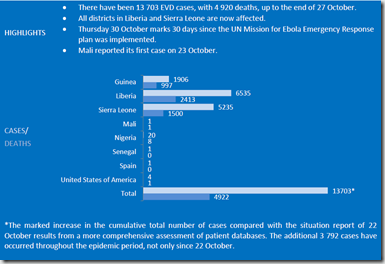# 9265
The WHO announced the big jump in numbers during a press conference earlier today, but the actual PDF document has just gone live, giving us more detail. Today’s report adds more than 3,500 cases to the total last reported on Saturday, but that number represents a `catch-up’ of cases over many weeks, not a sudden jump in cases.
While the total number of cases has increased, the number of deaths has actually gone down, as some previously identified `Ebola deaths’ have been reclassified.
One of the big question marks is what is happening in Liberia – an area that just a few weeks ago that was seeing an exponential growth in cases – but over the past two weeks has reported a substantial decline.
Whether this reflects the reality on the ground, a temporary blip, or a genuine trend is too soon to tell.
Some excerpts from today’s report below, but follow the link to read the report in its entirety.
EBOLA RESPONSE ROADMAP SITUATION REPORT
SUMMARY
A total of 13 703 confirmed, probable, and suspected cases of Ebola virus disease (EVD) have been reported in six affected countries (Guinea, Liberia, Mali, Sierra Leone, Spain, and the United States of America) and two previously affected countries (Nigeria and Senegal) up to the end of 27 October. There have been 4 922 deaths.
The outbreaks of EVD in Senegal and Nigeria were declared over on 17 October and 19 October 2014, respectively. EVD transmission remains persistent and widespread in Guinea, Liberia, and Sierra Leone. All administrative districts in Liberia and Sierra Leone have now reported at least one confirmed or probable case of EVD since the outbreak began.Cases of EVD transmission remain lowest in Guinea, but case numbers are still very high in absolute terms.
Transmission remains intense in the capital cities of the three most affected countries. Cases and deaths continue to be under-reported in the outbreak.
Of the countries with localized transmission, Mali, Spain and the United States of America continue to monitor potential contacts. In Mali, a 2-year-old girl died of Ebola on 24 October, after travelling with her grandmother from Guinea. The case makes Mali the sixth West African nation to be affected in the current Ebola outbreak.
In Spain, the single patient with EVD tested negative for the disease for a second time on 21 October. Spain will be declared free of EVD 42 days after the date of the second negative test, unless a new case arises during that period. In the US, two health-care workers have tested negative for Ebola for the second time, and have been discharged from hospital. Another health-care worker remains in isolation and is receiving treatment.<SNIP>
LIBERIA
Liberia has reported 6 535 confirmed, probable, and suspected cases, and remains the country worst affected by the outbreak (figure 2).
The most intense transmission continues to occur in the Montserrado area, where 30 new probable cases were reported in the last full week. This region takes in the Liberian capital, Monrovia. The weekly increase in new cases in the area, however, appears to have halted since mid-September, with a reduction in numbers of confirmed and probable cases reported in the week ending 5 October. It is possible that this reflects a true reduction in incidence. However, further data are needed to resolve this question. Liberia continues to report few confirmed cases. Laboratory data on recent confirmed cases may provide scope for deeper analysis not currently provided by the incidence data. The capacity to capture a true picture of the situation in Liberia remains hamstrung by underreporting of cases.Outside Monrovia, most newly reported cases have come from the districts of Bong, Margibi, and Bomi, which each reported 12 probable cases in the last full week. The district of Grand Gadeh, which was previously considered the only unaffected area in Liberia, now has 2 confirmed and 2 suspected cases. It is likely, however, that these cases did not occur in the past week, and the reporting of these cases has been delayed. Data for Liberia are missing for 19, 20, 21, 26 and 27 October.
<SNIP>
HEALTH-CARE WORKERS
A total of 521 health-care workers (HCWs) are known to have been infected with EVD up to the end of 27 October, 272 of whom have died (table 2). The large rise in the number of infections of HCWs in Liberia reflects changes in its method of reporting, and the inclusion of cases that had previously not been reported.
WHO is undertaking extensive investigations to determine the cause of infection in each case.
Early indications are that a substantial proportion of infections occurred outside the context of Ebola treatment and care. Infection prevention and control quality assurance checks are now underway at every Ebola treatment unit in the three intense-transmission countries. At the same time, exhaustive efforts are ongoing to ensure an ample supply of optimal personal protective equipment to all Ebola treatment facilities, along with the provision of training and relevant guidelines to ensure that all HCWs are exposed to the minimum possible level of risk.


